Prickly sida or tea weed has increasingly become more of an issue in soybeans. There are two reasons for this. First, the Group 15 herbicides (Dual Mag, Warrant, Zidua) are the most common PRE-applied herbicides utilized. Though that group of herbicides provides good residual control of pigweed and grasses, it provides no help on sida. Second, is that glyphosate nor dicamba has ever been very effective on this weed. The only POST option that can give some control is Liberty. However, even Liberty is limited to controlling only very small (<3”) prickly sida. Continue reading
Category Archives: Soybean
It is “Burndown Time in Tennessee.”
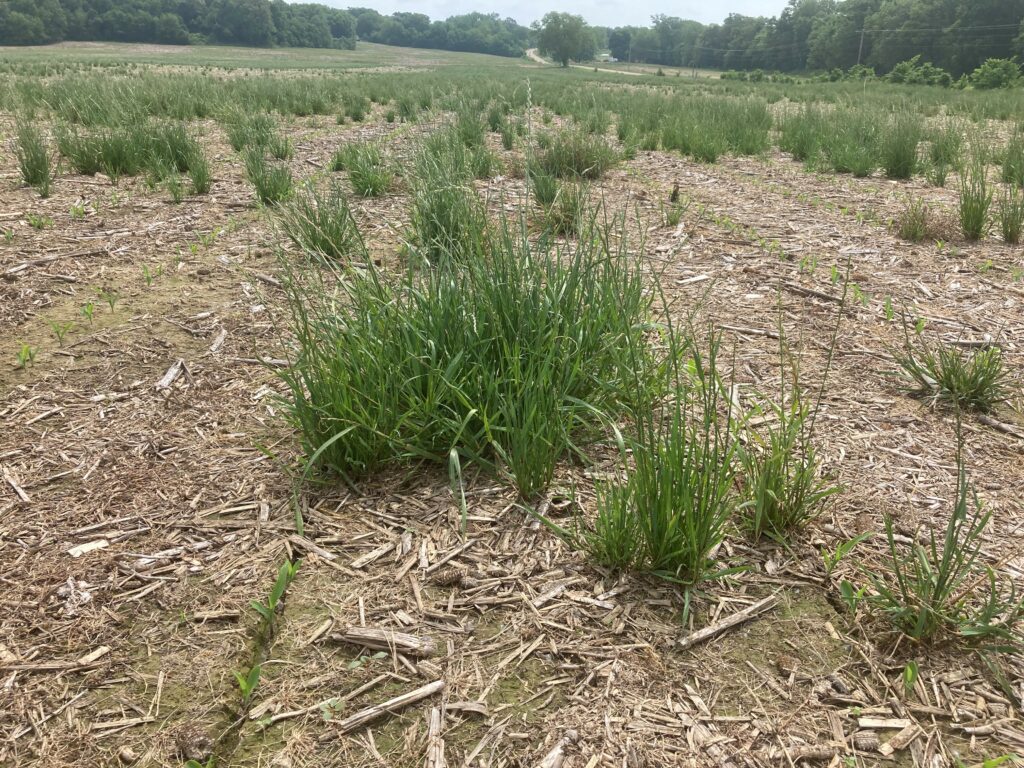
The combination of some lingering supply chain issues, most notably Sharpen and Verdict are in tight supply, with the ever-increasing presence of herbicide resistant weeds has made burndown time more of a challenge. On a positive note, glyphosate is in great supply and down in price about 40% compared to last year. Continue reading
2022 Soybean Variety Trials in TN – Now Available
 Results from the 2022 TN soybean variety trials are now available as pdf and excel files and will be posted at search.utcrops.com/soybean. Seventy-five varieties were evaluated in small plot replicated trials (REC) at nine locations and fifty-seven varieties were evaluated in three to nine locations as non-replicated large strip plots (CST). Quality and agronomic traits are reported for the REC trials and disease data are reported for CST trials. A summary of varieties that were in the yield “A group” (not statistically different from the top yield within each test) in either the REC or CST trial can be viewed here 2022 Soybean A Table.
Results from the 2022 TN soybean variety trials are now available as pdf and excel files and will be posted at search.utcrops.com/soybean. Seventy-five varieties were evaluated in small plot replicated trials (REC) at nine locations and fifty-seven varieties were evaluated in three to nine locations as non-replicated large strip plots (CST). Quality and agronomic traits are reported for the REC trials and disease data are reported for CST trials. A summary of varieties that were in the yield “A group” (not statistically different from the top yield within each test) in either the REC or CST trial can be viewed here 2022 Soybean A Table.
Weed Management Report Card 2022
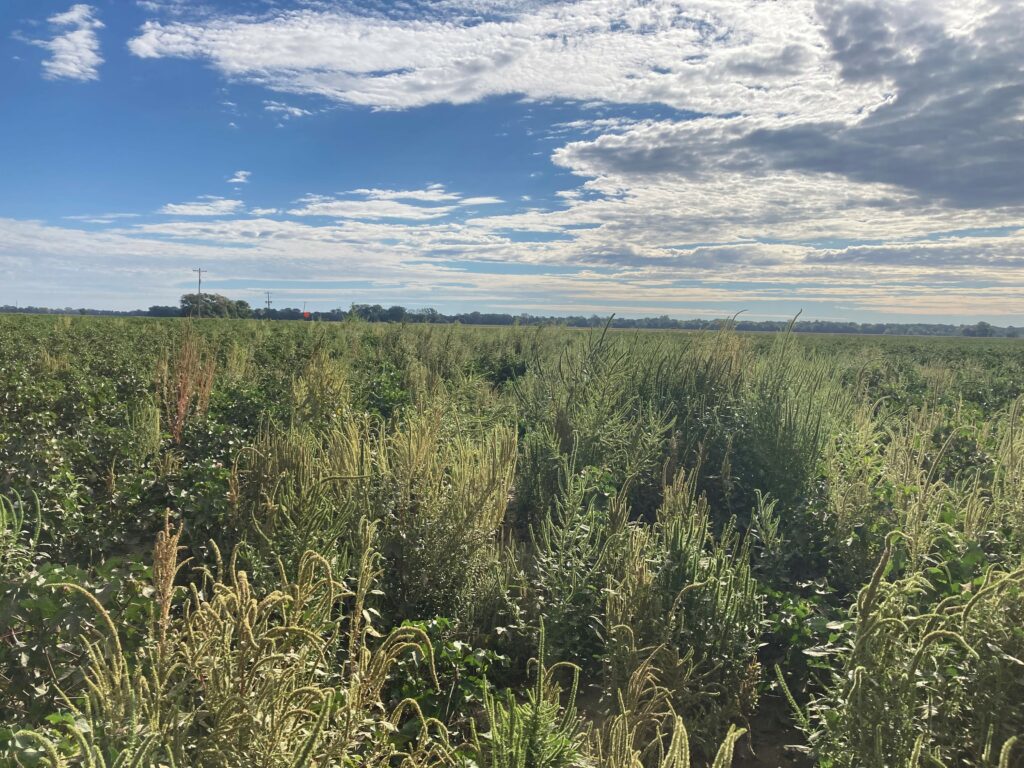
Every fall we travel around the state and observe the overall success or failure of weed control in our row crops. From the Palmer amaranth standpoint a few too many fields look like a failure. Particularly, from Gibson county across to Lauderdale county cotton and soybean fields ranged from clean fields to fields with more weeds than one would like (Picture 1) to completely grown up pigweed messes (Picture 2). Continue reading
Soybean Looper Numbers Increasing
I’ve received several calls about looper numbers increasing in soybeans across West Tennessee. Numbers range from 3 per 25 sweeps to 25 per 25 sweeps. Treatment is recommended when defoliation exceeds 20% from R1 to R6 or if looper numbers exceed 19 per 25 sweeps. It’s often suggested to ignore small worms (<1/2 inch) in these counts due to predators and entomopathogens taking a substantial toll on their survival.
Pyrethroid additions, at R3 fungicide timing, can exacerbate looper numbers and shouldn’t be included unless they are needed. This is one of the reasons I caution against including an automatic pyrethroid with fungicides at R3 and those applications won’t have any measurable impact on stink bug numbers when the beans hit R5. Loopers are one of the top pests encountered in late planted soybeans and are the most expensive to control. Further, I received word from my colleagues in Mississippi that low rates of diamides (1.2 fl oz/a Vantacor, 7.0 fl oz/a Besiege, 14.0 fl oz/a Prevathon) are providing unacceptable levels of control in large populations of loopers. This isn’t a surprise but take caution when utilizing diamides. Reports of diamide slippage on loopers has occurred for several years and more often than not, it occurs when low rates are utilized against high numbers (>1.5X threshold). Another product, Intrepid 2F (methoxyfenozide), has also had some control issues in Arkansas and Mississippi. Rates of 4.0 and 6.0 fl oz/a did not provide satisfactory control of loopers 7 days after application; however, Intrepid Edge (methoxyfenozide + spinetoram) performed very well. We have several insecticide options available at our disposal but if you’re facing large numbers, low rates of any product (especially the diamides) probably won’t cut it.
One final comment, don’t confuse soybean loopers with green cloverworms. Loopers have 2 pairs of prolegs cloverworms have 3 (see images below). Cloverworms are much easier to control than loopers and pyrethroids, as well as other insecticides, work well. Information on insecticide options for loopers can be found here: https://guide.utcrops.com/soybean/soybean-insect-guide/soybean-looper/
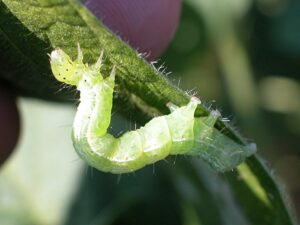
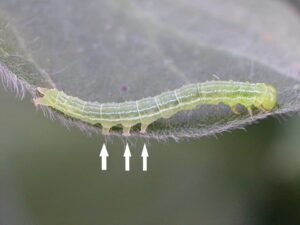
Insect Numbers Increasing in Soybeans
Insect infestations have been generally mild in soybeans thus far, but I am starting to get more calls about stink bugs and a few other pests. As other crops mature, including early maturing soybean fields, late season insect populations often concentrate in the green islands of soybeans in the field. This may include corn earworm infestations in our latest maturing fields.
Stink Bugs are the topic of most calls at this time. Here are a few points to consider.
- Populations often start building rapidly at about R5. It really doesn’t matter if you already sprayed a few weeks ago when applying a fungicide. Infestations often continue to build up to and past R7.
- Treatment for stink bugs is recommended when you average 9 or more insects per 25 sweeps until R6 (full seed in the top of the plant). The only caveat to this is the redbanded stink bug which has a threshold of 4/25 sweeps. I highly doubt we will experience redbanded stink bug infestations this year or if we do, it will be in the southern most counties in very late beans.
- You should double this threshold (18/25 sweeps) in next 7-10 days after fields reach R6.
- Green stink bugs have composed the majority of stink bugs we’ve found thus far. Pyrethroid insecticides such as Brigade and other bifenthrin products, Karate/Warrior, Mustang Max provide good control of green stink bugs. I would be more inclined to use Orthene/Acephate if brown stink bugs are usually common.
I’ve also received a few calls about worms in beans. So far, soybean loopers haven’t shown up on a large scale and most fields have a mix of loopers, cloverworms and other assorted worms. With worms in beans, coverage is typically more important than insecticide rate. Corn earworms respond to lower rates of diamides (Vantacor, Elevest, Besiege) in soybeans than in cotton. Similarly, Intrepid Edge is effective for corn earworms in beans but not particularly effective in cotton. Green cloverworms and velvetbean caterpillars are susceptible to pyrethroids and will often be removed by applications for stink bugs or other insects. Soybean loopers may require higher rates of diamides due to resistance issues. Soybean looper populations migrate from South/Central America every year and resistance levels are hard to predict, control level/duration often decreases with lower rates of diamides.
Like our stink bug threshold, the defoliation threshold in soybean should be relaxed from 20% to 30-35% once fields reach R6. Making an insecticide application for defoliating pests once you are 7-10 days past R6 is not recommended. Don’t spray for defoliators if fields are beginning to turn color and naturally defoliate.
Dicamba-Resistant Waterhemp Becoming a Real Issue in Middle Tennessee Counties Bordering Kentucky
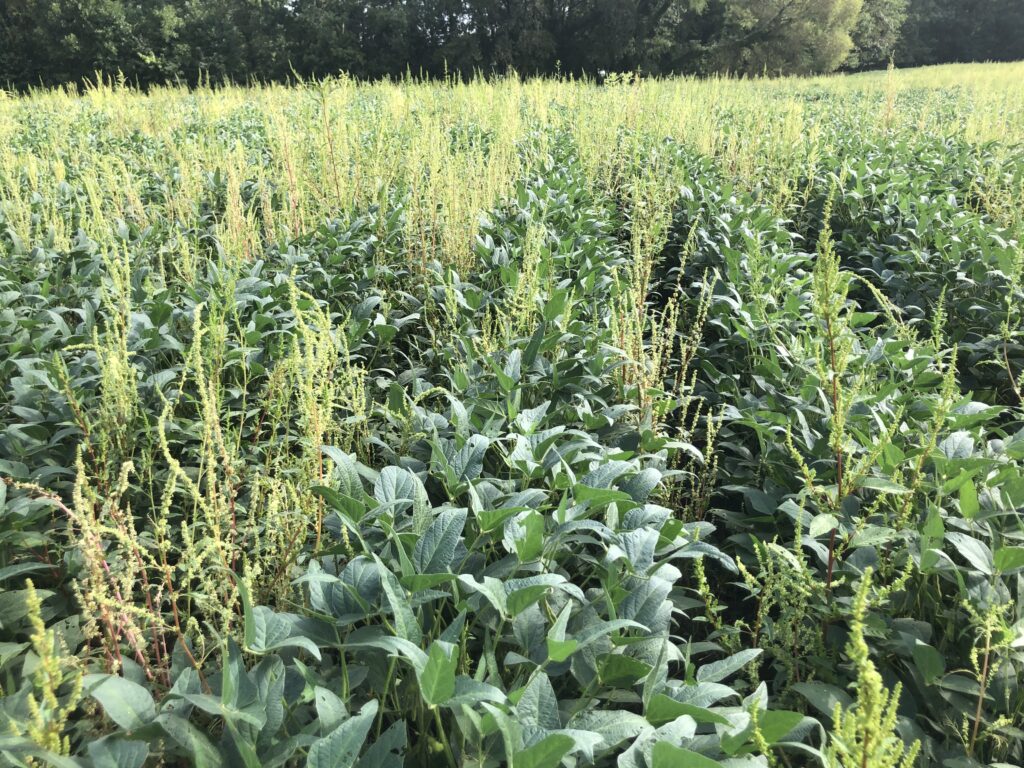
For the past several weeks we are getting reports of waterhemp escaping dicamba application/s from retailers and consultants scouting fields in Montgomery and Macon counties. As one retailer so aptly described it today “combines have spread it and we are fighting it all over the county now”. Continue reading
Bollworm/Budworm Moth Trap Catches (8/12)
| Weekly Moth Trap Data | ||
| Date: 8/12 | ||
| Location | Bollworm | Tobacco Budworm |
| Hardeman (Bolivar) | 2 | 1 |
| Fayette (Whiteville) | 3 | 0 |
| Fayette (Somerville) | 0 | 0 |
| Shelby (Millington) | 13 | 16 |
| Tipton (Covington) | 0 | 0 |
| Tipton (North) | 0 | 0 |
| Lauderdale (Goldust) | 53 | 14 |
| Haywood (West) | 3 | 0 |
| Haywood (Brownsville) | 1 | 0 |
| Madison (WTREC) | 23 | 0 |
| Madison (North) | 1 | 2 |
| Crockett (Alamo) | 0 | 1 |
| Crockett (Maury City) | 1 | 0 |
| Dyer (Kings Rd) | 13 | 3 |
| Dyer (Newbern) | 1 | 4 |
| Lake (Ridgely) | 3 | 35 |
| Gibson (Kenton) | 11 | 2 |
| Gibson (Milan REC) | 3 | 1 |
| Carroll (Atwood) | 29 | 3 |

